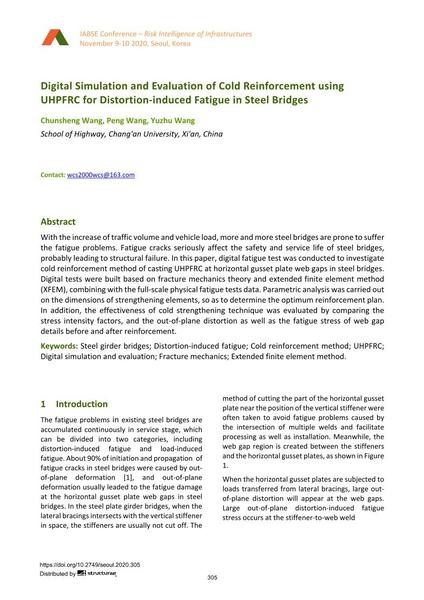Digital Simulation and Evaluation of Cold Reinforcement using UHPFRC for Distortion-induced Fatigue in Steel Bridges

|
|
|||||||||||
Bibliographic Details
| Author(s): |
Chunsheng Wang
(School of Highway, Chang'an University, Xi'an, China)
Peng Wang (School of Highway, Chang'an University, Xi'an, China) Yuzhu Wang (School of Highway, Chang'an University, Xi'an, China) |
||||
|---|---|---|---|---|---|
| Medium: | conference paper | ||||
| Language(s): | English | ||||
| Conference: | IABSE Conference: Risk Intelligence of Infrastructures, Seoul, South Korea, 9-10 November 2020 | ||||
| Published in: | IABSE Conference Seoul 2020 | ||||
|
|||||
| Page(s): | 305-312 | ||||
| Total no. of pages: | 8 | ||||
| DOI: | 10.2749/seoul.2020.305 | ||||
| Abstract: |
With the increase of traffic volume and vehicle load, more and more steel bridges are prone to suffer the fatigue problems. Fatigue cracks seriously affect the safety and service life of steel bridges, probably leading to structural failure. In this paper, digital fatigue test was conducted to investigate cold reinforcement method of casting UHPFRC at horizontal gusset plate web gaps in steel bridges. Digital tests were built based on fracture mechanics theory and extended finite element method (XFEM), combining with the full-scale physical fatigue tests data. Parametric analysis was carried out on the dimensions of strengthening elements, so as to determine the optimum reinforcement plan. In addition, the effectiveness of cold strengthening technique was evaluated by comparing the stress intensity factors, and the out-of-plane distortion as well as the fatigue stress of web gap details before and after reinforcement. |
||||
| Keywords: |
fracture mechanics UHPFRC steel girder bridges Distortion-induced fatigue Cold reinforcement method Digital simulation and evaluation Extended finite element method
|
||||
